The Beginning
If society ever collapses to the point where I’m judged to be a suitable contestant on Mastermind, my specialist subject will be ‘Sparklets’ soda syphons of the 1960s and 70s’. I’ve been fascinated by these ever since the time my parents got one in the early 1960s, probably for a shilling a week from the Littlewood’s catalogue. It was shiny red and I thought it was the poshest thing I had ever seen.
I don’t recall it ever being used, which is unsurprising as neither of my parents drank and, at least in the early days, we didn’t have running water and certainly would not have squandered any of the buckets-full of pump water that it was my job to fetch from the nearby farm every day on something as frivolous as fizzy drinks.
Nevertheless, it took pride of place in the front room and was a constant source of conversation with visitors.
Building The Collection
Almost thirty years later, my interest in soda syphons was rekindled by the rise in the popularity of car boot sales in the early 1990s. These were the golden years of car boot sales, comprising almost exclusively ordinary people clearing out their garages and attics for little more than pocket money in the days before the traders moved in and prices began their inexorable rise.
There were rich pickings to be had in those early days and I could almost guarantee to pick up at least one syphon for 50 pence or a pound at each boot sale. And I went to three or four a week over the summer months. I started off buying only ones that I hadn’t already got, but the addiction soon took hold and, if a car boot sale contained a soda syphon, I bought it.
Matters came to a head in about 1993 when BBC Children In Need promoted an attempt to set the record for the World’s Largest Car Boot Sale that was being made at the Norfolk Show Ground at Norwich the following weekend. This was too good to miss so my other half and I set off in our trusty Nissan Urvan which had been converted to a camper (OK, it was a van from a scrapyard that somebody had put a bed in) on the 200-mile journey to Norwich, determined to make a full weekend of it.
Earlier that year, we had set up a bric-a-brac shop (which we named ‘The Tat Gallery’) in a larger gallery in Hungerford and we determined to come back with a van-full of miscellaneous stock for it, including every soda syphon in the Show Ground. We had already sold a few syphons, and they were reasonable earners, but my private aim was to build up my own hoard and only put selected specimens on sale in The Tat Gallery.
I never found out if that boot sale was recognised as the world’s largest, but if there has been a bigger one, I’d like to see it. Google tells me that the site is 150 acres, and it seemed to me that it was completely full of cars, all with boots open and paste tables set out with what looked like the contents of every garage and attic in the country. Including soda syphons!
While my other half swooped on everything ‘art deco’, ‘shabby-chic’ or just plain ‘old’, I was on a soda syphon hunt. A very successful hunt as it turned out.
A hunt not without its problems though. Soda syphons are not very easy to carry in bulk, and the van was too far away to make frequent trips to offload. I quickly found the solution was to hook the lever of each syphon I bought in my belt and consequently spent my time walking around looking like a Papua New Guinean witch doctor with a particularly gaudy collection of shrunken heads. Only when I started to resemble a multi-coloured Michelin Man, and sellers began to realise that I was a sucker for their syphons and charged accordingly, did we go back to offload and have a sit down before setting off on the hunt again.
It took us all of the Saturday and half of the Sunday to visit the whole boot sale, by the end of which the van was full and we were exhausted. To my regret, I have forgotten how many syphons I bought in total, but it must have been several dozen as we kept The Tat Gallery in syphons for a couple of years and to this day I still have 35 left.
For several years after we gave up The Tat Gallery, my collection of soda syphons languished in the loft, which was ironic as it was lofts from where they had originally come! As I would have been glared at if I suggested putting them on show in the house there they stayed until, in 2011, we designed, built and began running a music rehearsal studio and decided that we needed something distinctive to set off the kitchen and chill-out area. What better, we felt, than a fine array of soda syphons. And so they were brought out of storage and took pride of place there, drawing (mainly) admiring comments for the next six years.

Since then they’ve been skulking in plastic bags in the shed until I came across them recently and decided to find out a bit more about them. On Googling, I wasn’t really surprised to find that there is a thriving site devoted to just such soda syphons and I am indebted to Tony Cook of https://www.sparklets.net/ for the details below. The photos are of syphons in my own collection.
The Models
Ten different models were produced between the beginning of the 60s and the end of production in 1981, and I am lucky enough to have at least one example of eight of them. I’m sure the missing models – Streamline Deluxe and Hostmaster Mk1 – will turn up one day. . . .
Streamline (UK) 1946-1965
Streamline was the first metal model produced in the UK following the Second World War. They came with 3 or 4 coloured bands and were finished in chromium plate, hammered grey enamel and smooth enamel. ‘Streamline’ defined the Sparklets syphon. Base markings (ie the manufacturer’s mark stamped on the base of the syphon): Made in England
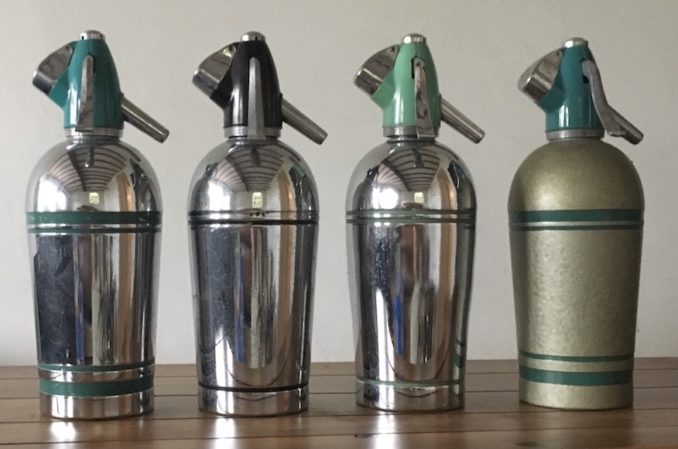
Hostmaster Mk2 1959-1968
Produced in high volumes when the sale of the syphons really took off in the 1960s. There are 10 colours to find and also a rare variant with 3 rings near the top of the body. Base markings: SC1/Z

Globemaster 1960-1980
The iconic round Globemaster is twice the capacity of its predecessors and needs 2 sparklets bulbs to charge it. It had a new head with a longer spout. Produced in 7 glorious colours and white. Base markings: SE/W.
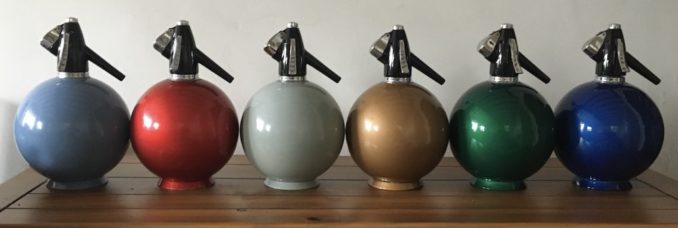
Stainless Steel Mk2 1963-1967
A very stylish stainless steel model, finished in mirror or satin, with either red or black matching head. Base marking: SF/Z or SB/Z
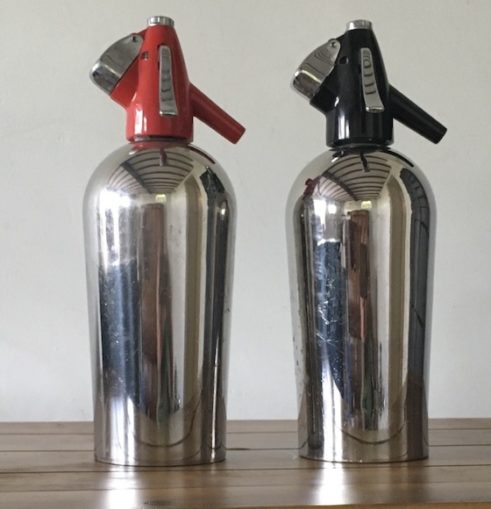
New Streamline 1965-?
A stainless steel Streamline which looks identical to the Chromium Plate Streamline Deluxe. Base markings tell it apart. Base markings: SF/Z
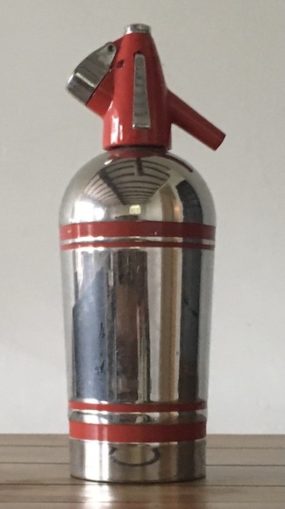
Hostmaster Mk3 1967-1981
When we think of a Sparklets syphon, the ruby Hostmaster Mk3 is the image in our minds, and it is probably the biggest seller. This range has the teardrop shape. Base markings: SHU

Aquarius Mk3 1967-1981
This range has the ’70’s look! 3 models had a circles design, and 3 models had a squares design. All were in a funky 1970’s colour. Base markings: SHU

Stainless Steel Mk3 1967-1981
The last syphon range which included bodies in satin and mirror stainless. Base markings: SJU
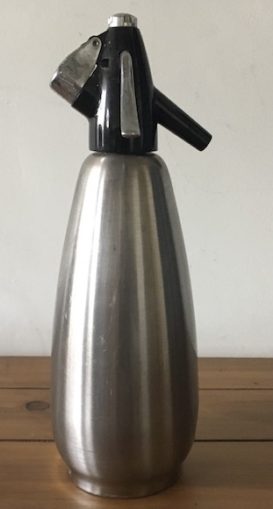
The Collection
The whole collection, seen here enjoying an afternoon in the sun. Sadly, they’ll be going back in the shed as soon as I’ve finished this article.

Postscript: if any readers feel that a collection of 35 soda syphons isn’t quite ‘niche’ enough to merit interest on this site, worry not – I also have a collection of xx Lava Lamps. . . .
© Text and photographs Jerry F 2022



